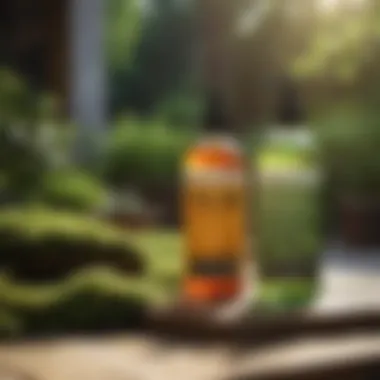A Comprehensive Guide to Effective Moss Killer Products


Overview of Topic
Moss is a common problem for many homeowners. It can grow on lawns, roofs, and walkways, leading to unsightly appearances and potential damage. Understanding the significance of moss control is crucial in maintaining the health of your outdoor spaces. This guide will explore moss killer products, focusing on their active ingredients, safety protocols, and application methods.
Moss not only detracts from curb appeal but can also create slippery surfaces, posing safety hazards. Recognizing the importance of addressing these issues can encourage homeowners to take preventive measures before the situation escalates.
Common Challenges and Solutions
Many homeowners struggle with moss infestations in various areas. The most common issues include:
- Excessive moisture due to shade and poor drainage
- Lack of sunlight,
- Compacted soil.
To overcome these challenges, consider the following solutions:
- Enhance sunlight access by trimming overhanging branches.
- Improve drainage by aerating soil and addressing any water pooling.
- Choose moss killer products designed for the specific type of surface you are treating.
Regular lawn maintenance and monitoring conditions can also reduce the likelihood of moss growth.
Product Recommendations
When it comes to addressing moss, choosing the right product is key. Here are some recommended products:
- Helena Chemical Company’s BARENBRUG Moss Control: This product contains iron sulfate, effectively killing moss while being safe for grass.
- Scotts Mossex: This solution not only kills moss but also helps to enhance grass growth by enriching the soil.
- Bonide MossMax: A liquid concentrate that provides fast-acting results, safe for both lawns and walkways.
Each of these products stands out for their distinct features and efficiency in moss control. Before selecting a product, review the active ingredients and suitability for your specific needs.
Step-by-Step Guides
Implementing successful moss control requires careful planning. Here is a practical guide:
- Assessment: Start by identifying areas with moss growth. Pay attention to shaded or damp spots.
- Preparation: Clear the area of debris to ensure the moss killer reaches the moss effectively.
- Application: Follow the manufacturer’s instructions for the chosen product. Apply during dry weather for optimal results.
- Follow-up: Monitor the treated areas over the next weeks. It may be necessary to reapply if moss persists.
- Preventative Maintenance: Implement regular maintenance practices, such as aerating and controlling moisture levels.
"Regular inspections and timely treatments are essential to keep moss at bay. Effective use of moss killer products can dramatically improve the health of your outdoor spaces."
By following these steps and utilizing effective products, homeowners can regain control over their outdoor environments and enjoy clear, moss-free spaces.
Prolusion to Moss Growth
Moss growth is a significant topic for homeowners and garden enthusiasts. Understanding why moss flourishes and how to effectively manage its presence can make a notable difference in maintaining healthy, vibrant landscapes. Moss can indicate specific environmental conditions that could be detrimental to other plants, showing us a bigger picture of our garden's health.
Understanding Moss
Moss is a non-vascular plant, closely related to ferns and liverworts. Unlike flowering plants, it does not have roots, stems, or leaves in the traditional sense. Instead, mosses absorb water and nutrients directly from the environment. A key point to note is that moss thrives in damp, shaded areas, which can often lead to issues in gardens and on lawns.
Moss comes in many species, each with unique characteristics making them adaptable to different environments. They are essential for ecosystem health, promoting moisture retention and providing a habitat for various organisms. However, for homeowners, uncontrolled moss growth can be frustrating, especially when it outcompetes more desirable plants.
Conditions Favoring Moss Growth
There are several conditions that favor the growth of moss. Understanding these conditions aids in prevention and control.
- Moisture: Moss requires a consistently damp environment to thrive. This often occurs in poorly drained areas of the garden or where water collects after rain.
- Shade: Moss tends to grow in shaded areas. Thus, lawns and gardens with dense trees or structures that block sunlight are more prone to moss development.
- Acidic Soil: Moss prefers acidic conditions, thriving in soil with a pH below 6. This can be further aggravated by soil compaction, which restricts airflow and water drainage.
- Low Fertility: In nutrient-poor soils, moss can take advantage of the lack of competition from other plants that might otherwise thrive in richer soils.
By recognizing these factors, homeowners can take informed steps to mitigate conditions that foster moss growth, leading to a healthier garden environment.
Overview of Moss Killer Products


Understanding the various moss killer products is crucial for effective moss control. In this section, we delve into the different types of moss killers and their active ingredients. This analysis will help homeowners make informed decisions when selecting products for their specific needs.
Types of Moss Killers
Chemical Moss Killers
Chemical moss killers are widely used due to their potency and quick action. These products often contain synthetic compounds designed to eliminate moss effectively. One key characteristic of chemical moss killers is their fast acting nature; they typically show results within a few days. This makes them a popular choice for those who want immediate results during turf maintenance or home landscaping projects. However, the primary concern with chemical options is their potential environmental impact. They may harm beneficial organisms in the soil, thus offering a mixed benefit. It is essential for users to handle these products with care and according to the instructions.
Organic Moss Killers
Organic moss killers offer a safer alternative for those looking to avoid harsh chemicals. These products often use natural ingredients that are less harmful to the environment. A notable highlight is the use of plant-based substances, which can effectively inhibit moss growth while preserving soil health. The benefits of organic solutions include their reduced toxicity and minimal environmental residue. However, users may notice that these products can be slower to act compared to chemical alternatives. It may take several applications to achieve desired results, which can be a drawback for some homeowners.
Homemade Solutions
Many users also consider homemade solutions for moss control. Common household items, such as vinegar, baking soda, and salt, can act as effective moss killers when correctly applied. A significant benefit of homemade solutions is their cost-effectiveness. Homeowners typically already have these items at home, which reduces the need for purchasing specialized products. On the downside, the effectiveness of homemade solutions can vary significantly based on the specific moss type and environmental conditions. Additionally, they may require repeated applications to maintain effectiveness, which could be inconvenient for some homeowners.
Active Ingredients in Moss Killers
The active ingredients in moss killer products play a vital role in their effectiveness. It is essential to understand these components for better selection:
Potassium Salts
Potassium salts are a common ingredient in many moss killers. They work by disrupting the cell structure of moss, causing dehydration and eventual death. One key characteristic of potassium salts is their relatively low toxicity to humans and animals, making them a reliable choice for those concerned with safety. However, while they are less harmful to the environment, their effectiveness can reduce in wet conditions, which should be a consideration for application.
Glyphosate
Glyphosate is another widely recognized ingredient found in moss killer products. This herbicide operates by inhibiting a specific enzyme pathway that is crucial for plant growth. Its primary advantage is its ability to knock back moss as well as other unwanted plants, making it a dual-purpose solution for some garden care needs. Nonetheless, glyphosate has been associated with environmental controversies, particularly concerning its impact on biodiversity. Users should consider these factors before opting for products containing glyphosate.
Ferrous Sulfate
Ferrous sulfate is effective in moss control, particularly on lawns. Its mechanism involves the breakdown of moss through oxidation. The key characteristic of ferrous sulfate is that it adds beneficial iron to the soil, which may improve lawn health. This dual function is a significant benefit for homeowners looking to maintain vibrant grass while controlling moss. However, it can leave temporary staining on driveways or patios if not applied carefully, which is a disadvantage to keep in mind.
Effectiveness of Chemical Moss Killers
The effectiveness of chemical moss killers plays a crucial role in their overall utility for home and garden care. These products often boast quick action, making them attractive for individuals battling moss problems. Understanding how they operate, their comparative effectiveness, and user experiences can guide homeowners in making informed decisions.
How They Work
Chemical moss killers function by targeting the moss directly, disrupting its cellular structure or physiological processes. The active ingredients disrupt key functions necessary for moss survival. For example, glyphosate works by inhibiting a specific enzyme pathway necessary for growth. On application, moss absorbs the chemical, causing it to die off rapidly. This is essential for effective control, especially in areas where moss could damage aesthetics or landscape health.
Comparative Effectiveness
Specific Brands
When discussing specific brands, products like Scotts MossEx and Bayer Advanced Moss Killer come to mind. Both of these options are widely recognized and recommended for their efficacy. Scotts MossEx contains potassium salts, which effectively target moss while being less harmful to surrounding vegetation. Bayer Advanced Moss Killer, on the other hand, combines ferrous sulfate with other ingredients, allowing for broader application against tough moss. The beneficial characteristic of Scotts MossEx is that it can be used safely around flowers and lawns, reducing the risk of collateral damage. While both products are effective, the choice may depend on individual environmental considerations.
User Reviews and Results
User reviews provide valuable insights into the effectiveness of these chemical products. Many users report faster results with products like Bayer Advanced Moss Killer compared to organic alternatives. Reviews often highlight its ability to handle large infestations quickly. However, some users express concern regarding the potential environmental impact. Many suggest using chemical moss killers in moderation, employing integrated pest management practices. The ability to read through reviews helps homeowners gather practical information on product performance, revealing which products may be well suited for their specific circumstances.
"Chemical moss killers can provide quick results, but understanding their application and effects is essential for long-term management."
In the quest for effective moss control, weighing both the immediate benefits and potential long-term implications of chemical moss killers is important. Recognizing how they work, comparing various brands, and reviewing user experiences will equip homeowners with the knowledge they need to address their moss issues effectively.
Using Organic Moss Killers
The use of organic moss killers is becoming increasingly popular among homeowners and gardening enthusiasts. There are several reasons for this trend. First, organic solutions are generally regarded as safer for the environment and human health. When compared to chemical alternatives, organic moss killers often have less impact on beneficial organisms in the garden. This can be especially important in residential areas or community gardens where children and pets may be present.


Furthermore, with a rising awareness of sustainable practices, homeowners look for ways to manage their lawns and gardens without introducing harmful chemicals into the ecosystem. Organic methods can align with these values. They offer practical solutions that are often more accessible and cost-effective. Homeowners should acknowledge that while organic solutions might not always provide instantaneous results, they contribute to long-term health and balance in the garden ecosystem.
Benefits of Organic Solutions
There are several clear advantages in using organic moss killers.
- Environmental safety: Organic products minimize the risk of chemical exposure to plants, soil, and water sources.
- Health consciousness: Reduced chemical usage means safer outdoor spaces for families and pets.
- Soil health: Organic solutions enhance the overall quality of the soil, improving its structure and fertility.
- Cost-effectiveness: Many organic moss control solutions can be created using common household items, making them more affordable.
In summary, choosing organic options can provide homeowners with a dependable method of managing moss while supporting environmental health.
Common Organic Ingredients
Several common household ingredients can be used as organic moss killers. They are effective and easily accessible.
Vinegar
Vinegar, particularly white distilled vinegar, contains acetic acid, which is harmful to moss. This characteristic makes vinegar a popular choice among those seeking organic solutions. The key benefit of vinegar is its availability and low cost. Being a natural ingredient, it poses no severe risk to non-target plants when used carefully. However, the effectiveness of vinegar may vary based on concentration and the state of the moss. High concentrations can harm nearby vegetation, so applying it with caution is essential for a successful outcome.
Baking Soda
Baking soda is another effective organic solution for moss control. Its primary action is through sodium bicarbonate, which disrupts the moss's cellular structure. As an interesting point, baking soda has a dual role; it not only works as a moss killer but can also help in preventing future moss growth. One disadvantage is that it may require multiple applications to achieve noticeable results. It is easy to use, and when mixed with water, it can be applied directly to affected areas with a spray bottle.
Salt
Salt is a traditional method known for its effectiveness against various types of moss. It affects moss through dehydration, leading to its demise. The primary characteristic of salt is its availability and simple usage. However, salt can severely impact surrounding soil health by altering its salinity levels. Therefore, it should be applied sparingly. Overuse can lead to long-term damage to the root systems of plants. Homeowners should be mindful and consider using it more as a last resort against stubborn moss.
Organic options for moss control are worth considering due to their safety and long-term benefits.
Application Techniques for Moss Killers
Understanding how to apply moss killers effectively is critical in achieving desired results in moss control. Application techniques can influence the efficiency of the treatment, its safety, and environmental impact. This section will outline the key methods for applying moss killer products, such as spraying, granular applications, and considerations for timing and frequency.
Spraying Techniques
Spraying is a direct and effective way to apply chemical or organic solutions to eliminate moss. The key benefit of this method is its flexibility and ability to cover large areas swiftly. When employing spraying techniques, precision is vital to ensure that the product reaches all affected areas without overspray.
- Equipment Preparation: Select appropriate spray equipment. A backpack sprayer or a hand-held spray bottle can be effective for smaller jobs, whereas larger areas may require a tank sprayer. Ensure the equipment is clean and in working order before use.
- Dilution and Mixing: If using concentrated moss killers, be sure to follow the manufacturer's instructions on dilution. Incorrect ratios can lead to ineffective treatments or potential damage to surrounding plants.
- Application Method: Aim the spray nozzle at the base of the moss, covering the infested areas uniformly. Avoid vigorous spraying to limit run-off. Control the pressure for even distribution and less misting.
- Weather Considerations: Apply moss killers on dry days with little or no wind. Moisture can dilute the effectiveness while wind can lead to accidental application onto desirable plants.
Granular Applications
Granular applications involve spreading moss killer granules over the affected area. This method is preferred for larger lawns or spaces where liquid applications are less practical. Granular formulations can offer prolonged action as they slowly dissolve and penetrate the moss and soil.
- Even Distribution: Use a spreader for uniform distribution of granules. Hand application can lead to uneven coverage, resulting in areas of moss untreated.
- Soil Interaction: Granular products benefit from moisture to activate their active ingredients. Water the area lightly after application or wait for rain, as this enhances effectiveness.
- Follow Up: After application, monitor the treated area for a few days. To maximize results, you might need to rake or brush the dead moss away to expose the soil, allowing further oxygenation.
Timing and Frequency of Application
Timing and frequency are critical elements in the moss control strategy. Applying moss killers at the right time can enhance effectiveness and prevent future growth.
- Optimal Times for Application: Spring and fall are typically the best times to apply moss killer products. During these periods, moss is actively growing, making treatments more effective.
- Frequency Recommendations: Generally, a single application may be sufficient for most moss infestations. However, if moss returns quickly, consider re-treating every six months or as necessary, based on growth conditions.
- Monitor Weather Changes: Weather plays a significant role in moss growth. After applying, keep an eye on rainfall, potential frost, and overcast days. Excess moisture can encourage moss regrowth, warranting further applications.
Important Note: Always read and follow label instructions to ensure safe and effective use of products.
These application techniques form the backbone of an effective moss control strategy. Adhering to the guidelines outlined will significantly improve the likelihood of successful moss removal. Understand how each method works in conjunction with environmental conditions to achieve optimal results.
Preventing Moss Growth


Preventing moss growth is essential for maintaining the health and aesthetics of lawns and gardens. This process is not only about removing existing moss but also about creating conditions that discourage its resurgence. Understanding how to effectively prevent moss growth can save homeowners time and money in the long run, and it contributes to a more vibrant landscape.
Cultural Practices
Cultural practices are a fundamental aspect of preventing moss growth. This involves managing the environment in which the moss thrives. Here are some specific practices to consider:
- Mowing Techniques: Regular mowing at the appropriate height can boost the health of grass and disallow moss from establishing itself. Grass often competes well against moss when kept at an ideal height.
- Watering Schedule: Adjusting the watering schedule can minimize damp conditions that favor moss growth. Water in the early morning instead of the evening to allow grass to dry out during the day.
- Sunlight Exposure: Moss tends to thrive in shady areas. Pruning trees and shrubs can increase sunlight exposure to the grass, thus helping it outcompete moss. This not only improves grass growth but also enhances overall health of your green areas.
- Soil Aeration: Aerating the lawn improves drainage and allows air to penetrate the soil, creating an environment less favorable for moss to flourish. This practice also supports deeper root growth for grass, making it stronger against moss intrusions.
By adopting these cultural practices, homeowners can significantly reduce the likelihood of moss appearing in their lawns and gardens.
Maintaining Healthy Soil
Healthy soil is the backbone of any successful plant growth, including grass. When soil is nutrient-rich and well-drained, it creates a less favorable environment for moss. The following elements are critical:
- Soil Testing: Conducting a soil test can reveal nutrient deficiencies that may contribute to unhealthy grass, providing insights into what amendments may be needed.
- pH Levels: Moss often thrives in acidic soil. Maintaining a neutral pH between 6.0 and 7.0 is beneficial for grass and may hinder moss growth. Adding lime can help to raise pH levels if tests indicate high acidity.
- Fertilization: Regular fertilization with a balanced fertilizer ensures grass receives necessary nutrients, outcompeting moss for resources. It is important not to over-fertilize, as this can lead to nutrient runoff and negatively impact overall soil health.
- Organic Matter: Adding organic matter such as compost improves soil structure, aids water retention, and provides nutrients. This can create a robust environment for grass and deter moss growth.
Through these efforts, maintaining healthy soil becomes a key strategy in preventing moss from taking over. Each practice contributes to creating an environment where grass can flourish, thereby keeping moss at bay.
“Prevention is key in managing moss and ensuring a lush lawn.”
By integrating these approaches into lawn care routines, homeowners can foster a thriving landscape, minimizing the frustration of moss encroachment.
Safety Considerations
Ensuring safety while using moss killer products is crucial for both personal health and environmental well-being. Homeowners can face various risks, from chemical exposure to the potential harm of accidentally contaminating surrounding plants or soil. This section examines key elements of safety when handling these products, emphasizing the importance of proper procedures and awareness.
Handling Chemical Products
When using chemical moss killers, following safety guidelines is essential. It is important to read the label carefully, as it contains vital information regarding the product's safe application. Here are a few primary points to consider:
- Personal Protective Equipment (PPE): Always wear gloves, masks, and goggles to protect your skin, eyes, and respiratory system. Avoid contact with skin and inhale any fumes.
- Storing Products Safely: Keep moss killers in a secure location, away from children and pets. Properly sealing containers can prevent leaks or spills.
- Dilution Guidelines: Follow specific dilution instructions on the label. Incorrect mixing can lead to either ineffective treatment or an overly concentrated solution that can harm the environment.
"Safety first: Understanding how to handle chemical products can prevent accidents and ensure effective moss control."
Environmental Impact
Chemical moss killers can pose risks not only to user safety but also to the environment. Here are some considerations:
- Runoff Concerns: Rain or watering can cause runoff, leading to the contamination of nearby water systems. This runoff can affect local wildlife and plant life.
- Impact on Soil Health: Chemical ingredients can alter the composition of soil, affecting beneficial microorganisms. Over time, this can lead to poor soil quality and hinder plant growth.
- Regulatory Compliance: Users must be aware of local environmental regulations concerning chemical application. Some regions may have specific guidelines or restrictions to prevent environmental damage.
It is vital for homeowners to balance effective moss control with sustainable practices. Evaluating both product ingredients and methods helps in minimizing negative impacts. This attentiveness will ensure that moss management is not only effective but also responsible.
Ending
The conclusion of this article serves as a critical summation of the varied findings related to moss killer products. It encapsulates the key points discussed in earlier sections while providing clarity on the efficacy, application methods, and potential side effects of these products. This synthesis is essential in helping readers solidify their understanding of how to effectively manage moss in various environments, including gardens and driveways.
Moss can be pervasive. Choosing the right moss killer not only maintains the aesthetic appeal of outdoor spaces but also protects the surface materials like concrete or wood from potential damage caused by moss growth. The choice between chemical, organic, or homemade solutions can be daunting. Thus, grasping the advantages and limitations of each type is beneficial for homeowners.
Summary of Findings
The exploration of different moss killer products reveals several significant insights:
- Types of Products: The market offers a range of options including chemical and organic killers, each with differing efficiency and application ease. Chemical solutions typically work faster, while organic options are favored for their environmental safety.
- Active Ingredients: Identifying key active ingredients, such as potassium salts or ferrous sulfate, allows consumers to make informed choices based on effectiveness and safety.
- Application Techniques: Spraying, granular application, and appropriate timing can influence the success of moss control efforts. Understanding these methods enhances application efficacy.
These findings underline the importance of selecting the right product tailored to specific conditions and preferences. By understanding the nuances involved, consumers are better equipped to handle moss effectively.
Future Considerations
Looking ahead, several considerations merit attention as the field of moss control continues to evolve:
- Innovative Solutions: The emergence of new products with enhanced safety profiles and effectiveness could reshape user choices. Ongoing research may lead to more eco-friendly options that do not compromise on performance.
- Environmental Impact: As awareness of environmental issues grows, there is a need for more environment-friendly moss control solutions. This shift may result in increased demand for organic and sustainable practices.
- Continued Education: Homeowners will benefit from ongoing education regarding best practices. Information shared through resources like articles, forums, and community groups can empower them to make informed choices and remain up-to-date on effective moss management strategies.
Through these considerations, readers can remain proactive and informed in their endeavors to maintain healthy and beautiful outdoor spaces.







